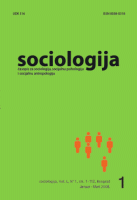Istraživanje socijalnih aspekata urbanog susedstva: percepcija stručnjaka na Novom Beogradu
Researching Social Aspects of Urban Neighborhood: Reflections of Professionals in New Belgrade
Author(s): Mina PetrovićSubject(s): Social Sciences
Published by: Sociološko naučno društvo Srbije
Keywords: urban neighborhood; community; social capital; quality of place; New Belgrade; professionals; interviews;
Summary/Abstract: Firstly, the paper aims to present basic analytical concepts in researching social aspects of urban neighborhoods: community, social cohesion, social capital, as well as relationship between physical and social structures within the neighborhood. Secondly, the paper presents empirical research that explores if there is a process of differentiation in the perception of neighborhood among professionals living in the neighborhoods exposed to significant changes in social and urban structures. By employing a qualitative methodology, based on interviews with 40 professionals in two types of neighborhoods (one exposed to social filtration and the other to the process of gentrification), the study reveals that neighborhood as a community prevails in all localities, that the neighborhood as a commodity develops more distinctively in better quality neighborhoods while the perception of neighborhood as a negative context (social and physical) emerges in lower quality neighborhoods. The importance of network support and reciprocity appeared equally developed in both residential areas, enhancing the sense of belonging to the neighborhood. The greatest difference was documented in respondents’ safety perception primarily due to differences in neighborhoods’ social context (crime, drug abuse and people from the margins in the lower quality area). Spatial characteristics influenced the perceived level of safety too (better equipment and security of buildings in the higher quality area). Social capital understood as potential resource that can be mobilized through intermediate institutions is generally low, without differences between the observed areas. It is visible in the tendency among all respondents to employ primarily the private sector in solving neighborhood problems instead of demanding institutional support, as well as in preferring the payment of services to participation in neighborhood activities.
Journal: Sociologija
- Issue Year: 50/2008
- Issue No: 1
- Page Range: 55-78
- Page Count: 24
- Language: Serbian

